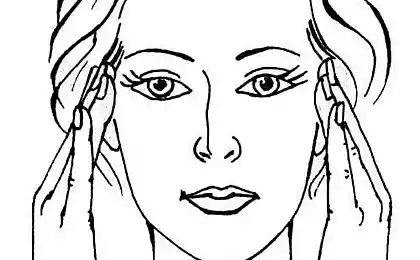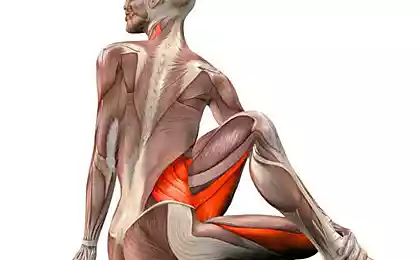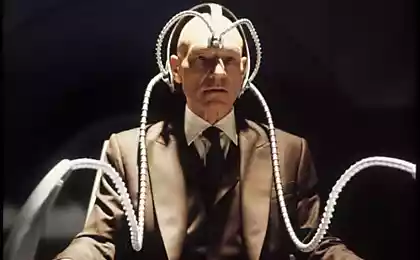399
Alexander Kiselev: How to fix flat feet and clubfoot
Correct flat feet, and especially clubfoot with the help of insoles-supinators - is like treating bedsores with a "comfortable" lying.
How to fix clubfoot
Not to be confused with “clutches” and “clutches”. They have a lot in common, but different degrees of neglect.
It is advisable to do this before the age of 6 “playfully”, i.e. without the participation of the child’s consciousness. Later, you will have to find convincing arguments to explain the need to do certain exercises, go to this and not that section, wear this and not another shoe.
The main task is to develop the child’s habit of moving properly. To do this, it is necessary to stimulate the work of those muscles that will straighten the injured (not correctly formed) joints.

Here are some of the exercises that will help your child solve this problem:
1. Squatting with a heavy ball in the lowered hands in the front. To do this, the child will have to split his knees and feet. The back is straight with a deflection in the lower back. Very boring exercise for kids. Better.
2. Raising the ball from the floor and throwing a friend, dad, mom, in the ring, in the box, etc.
3. "Bowling", only throw balls as in prop. 2.
4. Jumping on a ball with "ears" (between the legs).
5. Riding a horse. Focus on the heels. They should rest on the sides of the horse so that it is convenient to “spin”.
6. Swirls over your head forward/back. The knees are arranged so that the head of the child is placed between them, and not the knees would hit the teeth. I warn you, a very difficult exercise for the given foot and the X-shaped knees. This will most likely be your test for positive trends when corrected. To stimulate the development of this skill is necessary.
7. Tyre jumping. Its size depends on its age. Moving the body forward to the opposite part of the tire, then back. The legs are separated, then come together.
8. Walking “herringbird” on a board, a bar, as do gymnasts on a log.
9. Go down with a Christmas tree on the escalator moving up. Very emotional and effective exercise!
10. Spinning on the pianist's chair. We push back with one foot and throw the other side with the leg and knee removed. It looks like a stepping stone, only sitting on a rotating chair. We're going in different directions. Very useful for the vestibular apparatus.
11. "Go behind the closet." The main thing is that the space between the two obstacles is narrow at the place of setting the feet. Its width should be less than the length of the foot to stimulate its withdrawal.
12. Crawling in a plastuna manner under the closet, bench, etc. The lower abdomen and pelvis should not be removed from the floor. It's going to be hard at first.
13. Riding from the mountain on a sled lying on his stomach, the feet are divorced and do not touch the snow.
14. Standing on the outside of the foot with rolling. One foot is on the outside, the other stands as usual. We transfer body weights from one leg to the other, change the position of the feet. We develop the ankle joint, form an external vault, train the sequence of muscle interaction.
15. Football. One condition - hit the ball only "cheek".
16. Climbing.
17. Choreography.
18. Swimming "brasom" is a frog.
These, of course, are not all exercises, but basic exercises that I tested on myself, my own and other children.
I hope you noticed that most of the exercises tend to bring the child into the posture of the frog.
Think of your newborn baby for the first time. Whenever he was freed from his diapers, his legs would pull up and fly apart. His knees touched the sheet, especially when he fell asleep. The same position of the legs had when the baby, lying on his stomach, raised his head and bent the back.
Our swaddling, wrapping, etc. detrained joints and posterior-external muscles. The result is clubfoot, flatfoot, etc. Now we have to do the opposite.
Please do not put your left shoe on your right foot and your right shoe on your left, as some doctors advise. Apart from the negative, there will be no other effect. If you don’t believe me, try changing your shoes. And what?
The genius of this advice is only in what needs to be done exactly the opposite, the officially accepted method of treating ghosts. This is what I suggest you take advantage of.
“The best teacher is the wall. As long as you don't jump on her, you'll still hit her.” If you manage to equip your apartment, playground, garden, cottage, etc. with the necessary cabinets, walls and arouse interest in children to play "Your games", then in 2 - 3 years you will forget about the given foot and poor posture, and at the same time flat feet. It will only be necessary to ensure that the habits of proper movement are not replaced by fashionable “bumps” of transition periods.
How to fix flat feet
Exercises to correct flat feet, almost the same. The only thing, in some it is necessary to make adjustments in terms of limiting the maximum amplitudes in the presence of a large “luft” in the joints of the nacular bone (less often at the base of the first metatarsal). Visually, the inner surface of the foot will have an angle facing the opposite foot.
In other words, do not try to put the child in extreme (classical) positions of choreography until these joints are stronger. At the beginning, “train” the heel to be vertical, and the foot, “feel” comfortable on the outside. Initially, it is necessary to properly form the outer arch of the foot. He is the guarantor of the correct formation of the rest.
Flatfoot and clubfoot today are one of the most common defects, closely interrelated. Flatfoot without a lead can be found, a ghost without flatfoot is the exception rather than the rule. The ghost itself contributes to the blockage of the heel. And this is already an indicator of flat feet.
And one more very, very important detail. It is necessary to choose the right shoes, and then finish it yourself.
Exercise is, of course, a huge stimulant of the correct formation of the foot, but no matter how many repetitions you do, it is a drop in the bucket in comparison with the number of steps in the “wrong” shoes that our children make in a day.
Judge for yourself. Normative volume of movements on the pedometer for a day stay in a preschool institution (required in sandals!):
3 years - 9000 - 9500 movements
4 years - 10000 - 10500 ...
5 years - 11000 - 12000 ... .
6 years - 13000 - 13500 ... .
7 years - 14,000 - 15,000 ...
What? For comparison, we do about 5000 at a rate of 10,000 movements per day.
One way out:
1. Organize useful games
2. Put on the right shoes.
How to improve your shoes
Try to find shoes with solid soles or low heels. The problem is not so much in the presence of a heel (even "studies" can be made useful), but in its shape and placement, and most importantly in the absence of support under the base of the 5th metatarsal, which plays a dominant role in the formation of the arches of the foot. (This is a bone on the outside of the foot, approximately in the middle.) The sole should not be wide. The less she protrudes beyond the top, especially the heel, the better.
Let me give you an example for the most common form of sole.
(see picture and photo)
1. Cut the heel at an angle of 5-10 ̊. Remove the constructive blockage of shoes.
2. Determine the cut angle (αSR) and make a cut from the base to the upper or almost upper edge of the sole (depending on its design). Helps the muscles move the foot.
3. Round the outside of the front of the sole and the remaining heel. For smooth rolling and the formation of the outer arch of the foot.
4. Stick the insert under the heel (from the middle, at an angle of 25-30 ̊). For the formation of internal and transverse vaults by twisting the front of the foot relative to the rear.
5. Stick the insert under the heads of 2-4 paws (under the bases of 2-4 toes). For the formation of a transverse vault and training of the thumb. Note: for the given foot, the top is horizontal, for the flat and receded one is convex. Thickened inserts of 3-5 mm, depending on the age and degree of flattening of the foot.




The width of the insert No. 5 in the figure is not ideal, but is sufficient for the formation of a transverse vault during manual revision.




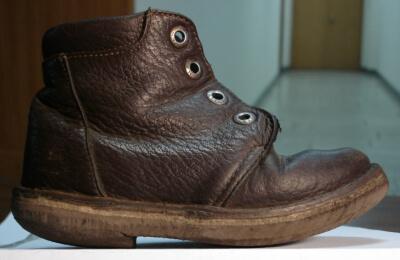
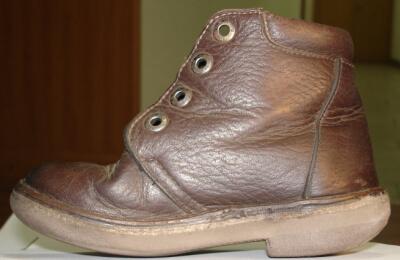
In the photos: the real heel bone in the back and one of my first improvements for the prevention and treatment of flat feet.
The above method of improvement is more effective. But this one works well, too. Pay attention to the heel. The cut is from the middle. The heel at the back is very similar to the heel bone of the foot (see photo). About the same angles. From the side, it is noticeable that the heel is rounded and quite significantly.
The modification was carried out with an ordinary boot knife. You can see the bumps on the side of the sole. They were about the same on their heels. Now, almost perfectly polished surface. This indicates how loaded, in terms of work, this element of the foot. So, how we load it (from what angles, etc.) depends on the formation of the foot itself.
I'm showing you these photos so you don't get upset about the aesthetic. No one will pay attention to that. Forms are crucial. We are so loaded with the mythical problems of perpetual pursuit of a carrot (like the donkey that hangs in front of its nose) that we do not see our own children.
Please remember. How are the shoes of a child, wife, husband, father, mother trampled? When was the last time you looked at your sole? ...
Now, what can you say about the top of a friend's shoes? I am sure that in this case we will be more verbose.
Believe me, children who are not interested in fashion (at least 6 years old) will wear what you give them well. Harder than that. It is very difficult psychologically to spoil a new thing bought with your own money! Especially when someone, and this is sure to be found, from loved ones regularly releases phrases in your address: “You are engaged in nonsense, it would be better to do ...”, “Everyone walks and nothing”, “It will not work anyway”, etc.
Personally, I didn’t get immunity for that kind of thing until three years later. You'll have to choose. Either you ruin your shoes or they cripple your and your baby’s legs. There is, however, another way - to organize the production of physiological shoes (not to be confused with orthopedic). In my opinion, this is the most reasonable decision. But not everyone can.
Salvation of the hands of those who drown. Finish your shoes, master physiological movements, and you will see excellent results. Of course, many shoes will not fulfill all my recommendations. The shoes will fall apart. Do at least part of it. It'll work anyway!
The angles in the drawing are mostly maximum. Depending on the shoes and the defect, they can be reduced, but not more than half.
Good luck thinking people!
Not much about wearing shoes.
I will not describe the physiological problems arising from the limited mobility of our toes. I'll say one thing. Connected and walled up with a narrow space of shoes, they contribute to the formation of foot defects, instead of their direct purpose - to stimulate its proper development.


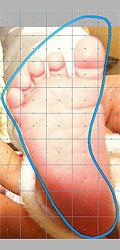
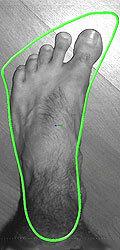


Brilliant! The almost perfect shape of the top of the shoe. Pay attention to the baby Czechs. It's so beautiful! It remains only to remove the seam from the outside and slightly change the heel. But even in this form, they are much more useful than modern sandals and Czechs. And it is quite possible that they will help correct clubfoot and flatfoot in children. It's theoretically possible. The main thing is to identify the root cause of the defect. Then it will be easier to choose a set of measures for correction. Try it! This is interesting! published
Author: Alexander Kiselev
Haruki Nakamura’s Simple Technique for Relieving Tension in the Neck Muscles and Improving Blood Circulation
Signs of high cholesterol in the blood – do not miss!
Source: www.kramola.info/vesti/protivostojanie/kak-ispravit-ploskostopie-i-kosolapie-aleksandr-kiselyov
How to fix clubfoot
Not to be confused with “clutches” and “clutches”. They have a lot in common, but different degrees of neglect.
It is advisable to do this before the age of 6 “playfully”, i.e. without the participation of the child’s consciousness. Later, you will have to find convincing arguments to explain the need to do certain exercises, go to this and not that section, wear this and not another shoe.
The main task is to develop the child’s habit of moving properly. To do this, it is necessary to stimulate the work of those muscles that will straighten the injured (not correctly formed) joints.

Here are some of the exercises that will help your child solve this problem:
1. Squatting with a heavy ball in the lowered hands in the front. To do this, the child will have to split his knees and feet. The back is straight with a deflection in the lower back. Very boring exercise for kids. Better.
2. Raising the ball from the floor and throwing a friend, dad, mom, in the ring, in the box, etc.
3. "Bowling", only throw balls as in prop. 2.
4. Jumping on a ball with "ears" (between the legs).
5. Riding a horse. Focus on the heels. They should rest on the sides of the horse so that it is convenient to “spin”.
6. Swirls over your head forward/back. The knees are arranged so that the head of the child is placed between them, and not the knees would hit the teeth. I warn you, a very difficult exercise for the given foot and the X-shaped knees. This will most likely be your test for positive trends when corrected. To stimulate the development of this skill is necessary.
7. Tyre jumping. Its size depends on its age. Moving the body forward to the opposite part of the tire, then back. The legs are separated, then come together.
8. Walking “herringbird” on a board, a bar, as do gymnasts on a log.
9. Go down with a Christmas tree on the escalator moving up. Very emotional and effective exercise!
10. Spinning on the pianist's chair. We push back with one foot and throw the other side with the leg and knee removed. It looks like a stepping stone, only sitting on a rotating chair. We're going in different directions. Very useful for the vestibular apparatus.
11. "Go behind the closet." The main thing is that the space between the two obstacles is narrow at the place of setting the feet. Its width should be less than the length of the foot to stimulate its withdrawal.
12. Crawling in a plastuna manner under the closet, bench, etc. The lower abdomen and pelvis should not be removed from the floor. It's going to be hard at first.
13. Riding from the mountain on a sled lying on his stomach, the feet are divorced and do not touch the snow.
14. Standing on the outside of the foot with rolling. One foot is on the outside, the other stands as usual. We transfer body weights from one leg to the other, change the position of the feet. We develop the ankle joint, form an external vault, train the sequence of muscle interaction.
15. Football. One condition - hit the ball only "cheek".
16. Climbing.
17. Choreography.
18. Swimming "brasom" is a frog.
These, of course, are not all exercises, but basic exercises that I tested on myself, my own and other children.
I hope you noticed that most of the exercises tend to bring the child into the posture of the frog.
Think of your newborn baby for the first time. Whenever he was freed from his diapers, his legs would pull up and fly apart. His knees touched the sheet, especially when he fell asleep. The same position of the legs had when the baby, lying on his stomach, raised his head and bent the back.
Our swaddling, wrapping, etc. detrained joints and posterior-external muscles. The result is clubfoot, flatfoot, etc. Now we have to do the opposite.
Please do not put your left shoe on your right foot and your right shoe on your left, as some doctors advise. Apart from the negative, there will be no other effect. If you don’t believe me, try changing your shoes. And what?
The genius of this advice is only in what needs to be done exactly the opposite, the officially accepted method of treating ghosts. This is what I suggest you take advantage of.
“The best teacher is the wall. As long as you don't jump on her, you'll still hit her.” If you manage to equip your apartment, playground, garden, cottage, etc. with the necessary cabinets, walls and arouse interest in children to play "Your games", then in 2 - 3 years you will forget about the given foot and poor posture, and at the same time flat feet. It will only be necessary to ensure that the habits of proper movement are not replaced by fashionable “bumps” of transition periods.
How to fix flat feet
Exercises to correct flat feet, almost the same. The only thing, in some it is necessary to make adjustments in terms of limiting the maximum amplitudes in the presence of a large “luft” in the joints of the nacular bone (less often at the base of the first metatarsal). Visually, the inner surface of the foot will have an angle facing the opposite foot.
In other words, do not try to put the child in extreme (classical) positions of choreography until these joints are stronger. At the beginning, “train” the heel to be vertical, and the foot, “feel” comfortable on the outside. Initially, it is necessary to properly form the outer arch of the foot. He is the guarantor of the correct formation of the rest.
Flatfoot and clubfoot today are one of the most common defects, closely interrelated. Flatfoot without a lead can be found, a ghost without flatfoot is the exception rather than the rule. The ghost itself contributes to the blockage of the heel. And this is already an indicator of flat feet.
And one more very, very important detail. It is necessary to choose the right shoes, and then finish it yourself.
Exercise is, of course, a huge stimulant of the correct formation of the foot, but no matter how many repetitions you do, it is a drop in the bucket in comparison with the number of steps in the “wrong” shoes that our children make in a day.
Judge for yourself. Normative volume of movements on the pedometer for a day stay in a preschool institution (required in sandals!):
3 years - 9000 - 9500 movements
4 years - 10000 - 10500 ...
5 years - 11000 - 12000 ... .
6 years - 13000 - 13500 ... .
7 years - 14,000 - 15,000 ...
What? For comparison, we do about 5000 at a rate of 10,000 movements per day.
One way out:
1. Organize useful games
2. Put on the right shoes.
How to improve your shoes
Try to find shoes with solid soles or low heels. The problem is not so much in the presence of a heel (even "studies" can be made useful), but in its shape and placement, and most importantly in the absence of support under the base of the 5th metatarsal, which plays a dominant role in the formation of the arches of the foot. (This is a bone on the outside of the foot, approximately in the middle.) The sole should not be wide. The less she protrudes beyond the top, especially the heel, the better.
Let me give you an example for the most common form of sole.
(see picture and photo)
1. Cut the heel at an angle of 5-10 ̊. Remove the constructive blockage of shoes.
2. Determine the cut angle (αSR) and make a cut from the base to the upper or almost upper edge of the sole (depending on its design). Helps the muscles move the foot.
3. Round the outside of the front of the sole and the remaining heel. For smooth rolling and the formation of the outer arch of the foot.
4. Stick the insert under the heel (from the middle, at an angle of 25-30 ̊). For the formation of internal and transverse vaults by twisting the front of the foot relative to the rear.
5. Stick the insert under the heads of 2-4 paws (under the bases of 2-4 toes). For the formation of a transverse vault and training of the thumb. Note: for the given foot, the top is horizontal, for the flat and receded one is convex. Thickened inserts of 3-5 mm, depending on the age and degree of flattening of the foot.




The width of the insert No. 5 in the figure is not ideal, but is sufficient for the formation of a transverse vault during manual revision.






In the photos: the real heel bone in the back and one of my first improvements for the prevention and treatment of flat feet.
The above method of improvement is more effective. But this one works well, too. Pay attention to the heel. The cut is from the middle. The heel at the back is very similar to the heel bone of the foot (see photo). About the same angles. From the side, it is noticeable that the heel is rounded and quite significantly.
The modification was carried out with an ordinary boot knife. You can see the bumps on the side of the sole. They were about the same on their heels. Now, almost perfectly polished surface. This indicates how loaded, in terms of work, this element of the foot. So, how we load it (from what angles, etc.) depends on the formation of the foot itself.
I'm showing you these photos so you don't get upset about the aesthetic. No one will pay attention to that. Forms are crucial. We are so loaded with the mythical problems of perpetual pursuit of a carrot (like the donkey that hangs in front of its nose) that we do not see our own children.
Please remember. How are the shoes of a child, wife, husband, father, mother trampled? When was the last time you looked at your sole? ...
Now, what can you say about the top of a friend's shoes? I am sure that in this case we will be more verbose.
Believe me, children who are not interested in fashion (at least 6 years old) will wear what you give them well. Harder than that. It is very difficult psychologically to spoil a new thing bought with your own money! Especially when someone, and this is sure to be found, from loved ones regularly releases phrases in your address: “You are engaged in nonsense, it would be better to do ...”, “Everyone walks and nothing”, “It will not work anyway”, etc.
Personally, I didn’t get immunity for that kind of thing until three years later. You'll have to choose. Either you ruin your shoes or they cripple your and your baby’s legs. There is, however, another way - to organize the production of physiological shoes (not to be confused with orthopedic). In my opinion, this is the most reasonable decision. But not everyone can.
Salvation of the hands of those who drown. Finish your shoes, master physiological movements, and you will see excellent results. Of course, many shoes will not fulfill all my recommendations. The shoes will fall apart. Do at least part of it. It'll work anyway!
The angles in the drawing are mostly maximum. Depending on the shoes and the defect, they can be reduced, but not more than half.
Good luck thinking people!
Not much about wearing shoes.
I will not describe the physiological problems arising from the limited mobility of our toes. I'll say one thing. Connected and walled up with a narrow space of shoes, they contribute to the formation of foot defects, instead of their direct purpose - to stimulate its proper development.






Brilliant! The almost perfect shape of the top of the shoe. Pay attention to the baby Czechs. It's so beautiful! It remains only to remove the seam from the outside and slightly change the heel. But even in this form, they are much more useful than modern sandals and Czechs. And it is quite possible that they will help correct clubfoot and flatfoot in children. It's theoretically possible. The main thing is to identify the root cause of the defect. Then it will be easier to choose a set of measures for correction. Try it! This is interesting! published
Author: Alexander Kiselev
Haruki Nakamura’s Simple Technique for Relieving Tension in the Neck Muscles and Improving Blood Circulation
Signs of high cholesterol in the blood – do not miss!
Source: www.kramola.info/vesti/protivostojanie/kak-ispravit-ploskostopie-i-kosolapie-aleksandr-kiselyov






